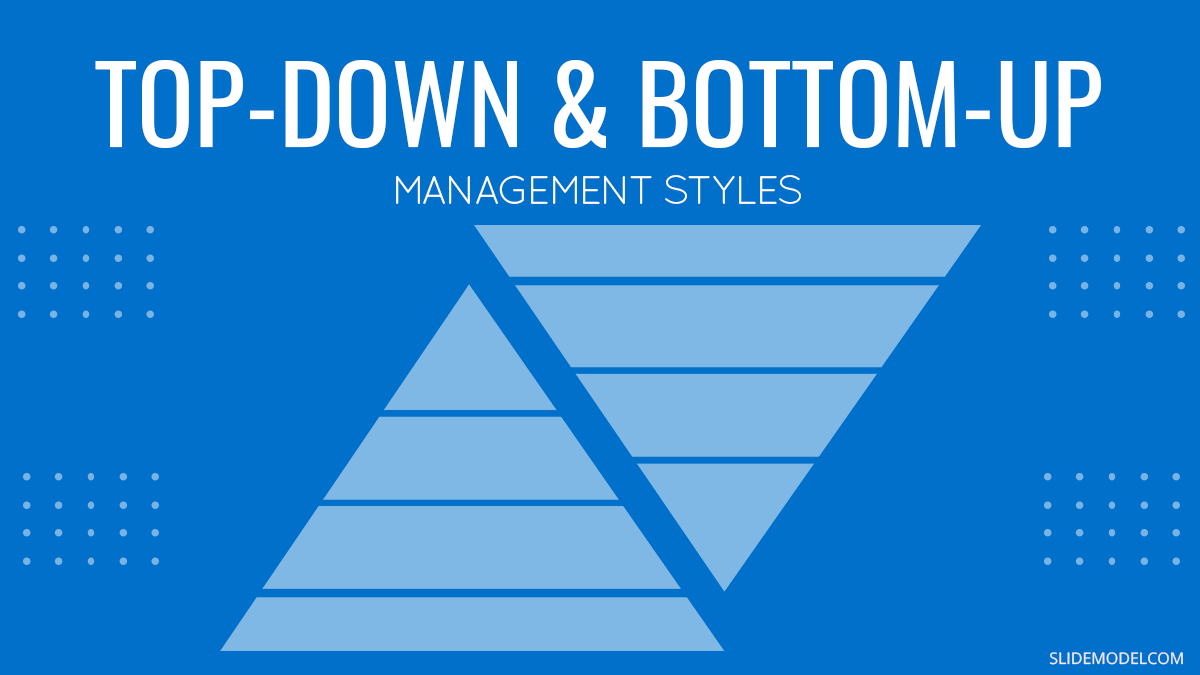
For decades, the predominant management style at most companies has been top down management, where leadership at the top of an organization dictates strategy and tasks for subordinates to carry out. According to Touro University, it wasn’t until the middle of the 20th century that some management trends started shifting to favor a bottom up approach.
Since then, the top down vs bottom up debate has swept across companies and organizations, both large and small. Here is a guide to understanding top vs bottom led management and deciding which to implement in different organizations.
What is Top Down Management
Top-down management is also known as autocratic leadership. In this management style, upper management makes all critical decisions about strategy, budget, products, and direction. Executives pass these decisions down the layers of the organization. The bottom layers of the organization are held responsible by their managers and supervisors to carry out the mission of the higher-ups. Each tier of the chain of command reports to another until they reach the top.
Of course, there are cases where middle management or even lower-level managers have a say in the decision-making process. However, the executives and the board of directors always make the final decisions.
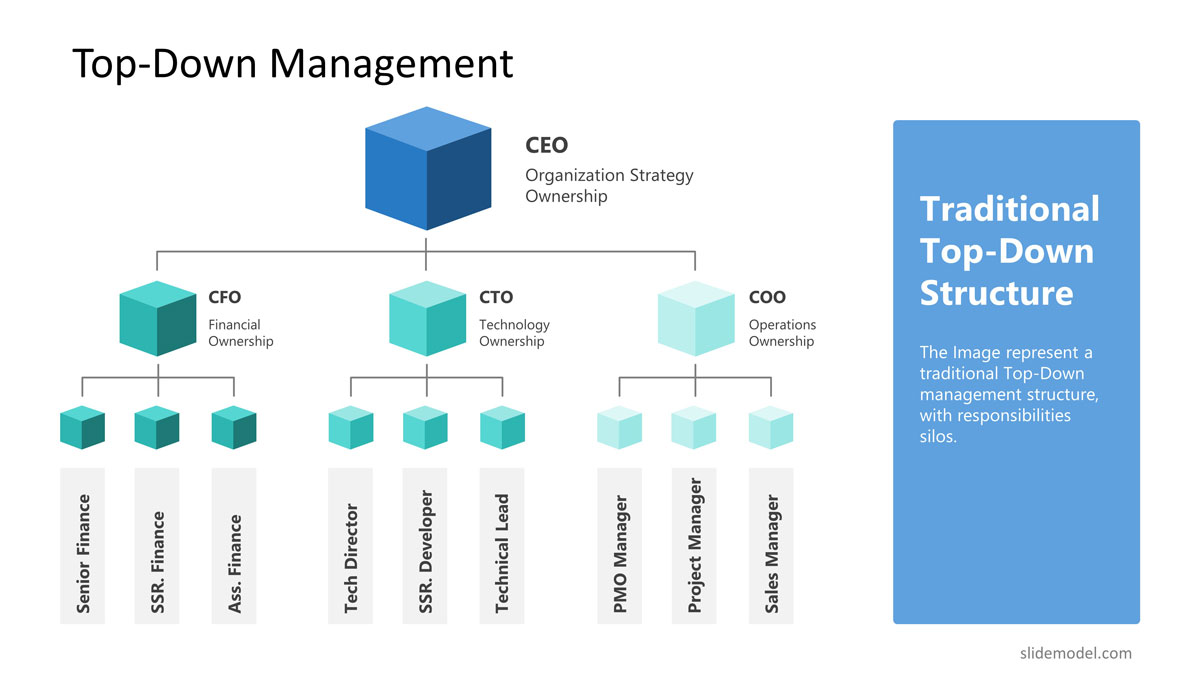
What Does Top Down Management Structure Look Like?
A top down organizational model will look like a classic pyramid with the CEO at the top. Directors, managers, team leads occupy the middle management rows of the organizational chart. Lastly, team members, employees, staff, workers, etc. occupy the bottom layers.
The higher up on the pyramid you go, the more decision-making power, autonomy, and agency you’ll find. Workers at the bottom are given tasks to carry out, which ultimately leads to the fulfillment of the overall strategy.
8 Pros to the Top Down Approach to Management
There are several benefits to maintaining top down control in a company.
1. Leaders can set clear objectives and expectations
In top down management, one message is communicated throughout the organization. Since there are fewer decision-makers, that message doesn’t get bogged down by people revising it, questioning it, and interpreting it their own way.
2. Top down is effective at maintaining control
Many industries have rigorous quality control, compliance, and safety regulations. Some examples include healthcare, manufacturing, and banking. For these industries, management needs to ensure that standards are met and that they comply with government regulations. In this case, a top down approach is often ideal for making sure this happens.
3. Communication and coordination are relatively quick and easy
Compare the situation where one person dictates a message to 100 people versus where 100 people debate what the message should be and how it should be carried out. This is a simplified comparison, of course. However, it does make sense that the first situation results in much quicker communication and coordination.
4. Top down management is familiar
Simply put, this is what most professionals have experienced throughout their careers. Very little training is needed to get new employees up to speed on the top down approach.
5. Employees have time to focus on work
Team members don’t have to first make decisions or participate in decision-making before they can sit down to work. This results in much more time to get that work down.
6. Organizations align towards specified objectives
There’s minimal discussion and debate about company direction. People carry out their tasks according to their assignments. This puts the whole organization on the same path towards achieving goals, working on projects, and executing tasks.
7. Top down management facilitates standardization
Everything is easier to standardize when everyone is on the same page, from company message and vision to products and services.
8. Lower risk in decision-making
The idea here is that those at the top of an organization have the most experience and information to make the best decisions for the company. While this depends on many factors outside the purview of top-down structure, when conditions are ideal, risks may be lower.
8 Top-Down Management Disadvantages
Here are some aspects that lead many to question the top down approach in their organization.
1. Disconnect between employee work and goals
The top down disadvantage here isn’t so much that employee work won’t fulfill the goals of leadership. The main problem is that employees might not see how their work fits into the bigger picture of the company goals. This could lead to confusion, discouragement, or suboptimal achievement.
2. Employees won’t know enough about the company
There may be a lot about a particular organization that employees never have an opportunity to see. Leadership may not think they need to know certain details. Where this becomes an issue is when employees don’t know what makes their particular organization distinguished. This may manifest as employees not knowing what their competitive edge is, what drives success and profitability, or even the company mission and vision.
3. They may be little feedback to leadership
The advantage we previously mentioned about lower risk depends wholly on the information leadership is able to attain. Since most of the communication runs from top to bottom, management may not be getting the feedback they need in order to make good decisions. Depending on their industry, much of that information may need to come from day-to-day operations and relationships with clients, something that lower level staff may not have the opportunity to share.
4. Top down control can feel oppressive
If top management lacks leadership skills, particularly soft skills, the control they maintain on the organization will potentially feel oppressive. When only one, or a few, opinions really matter, there’s a lot of pressure for those individuals to have appropriate leadership skills. Otherwise, they end up feeling like overbearing authorities, but not leaders.
5. Management may be slow to respond or pivot
There are two factors to this top down disadvantage. One factor is the time it takes information to get to management. Executives cannot make decisions on issues they don’t know are happening, for example. The other factor is how long it takes executives to decide their course and get everyone else on board. If a company needs to pivot in a new direction, or even decide to pursue a new opportunity, the top down approach sometimes struggles to respond fast enough.
6. Workers may not feel heard or valued
Team members may feel powerless when excluded from the decision-making process. While not all workers will want to be part of the process or be capable of it, some will usually be interested. If they cannot contribute significantly, they’ll be more likely to resign and look for other opportunities where their voices count.
7. Top down management doesn’t always encourage creativity
This warning depends on the industry and the organization. Just because a company uses the top down management style does not mean they will stifle creativity. It means that it may not be the ideal management style for inspiring diversity of thought or thinking outside the box.
8. Employees simply might not find their jobs satisfying
Job satisfaction depends on many variables. Work environment, leadership, opportunities, and being valued are just some of them. Often, if an employee doesn’t find their job fulfilling, it is because of almost intangible reasons and feelings. Not being heard, not being part of the process, and not even knowing what the process leads to their tasks could contribute to dissatisfaction.
How Can Companies Do Top Down Management Right?
Our main takeaways from these eight advantages and disadvantages of top down management can be boiled down to the following:
Information is vital.
With the right information, executives can make better decisions. If they don’t have the right information, don’t have enough information, or don’t get it fast enough, decision-making suffers.
Leadership
The success of the top down approach absolutely depends on the leadership skills of an organization’s management team. If a company wants to, or needs to, operate with a top down structure, they must invest in the best leadership. There is a lot of pressure on leadership with this management style.
Receive Messages from the bottom
While decisions may need to be made by executives, they should still enable some sort of bottom-up communication. At the end of the day, the top of the organization will have the final word. However, that doesn’t mean they can’t listen to various perspectives, ideas, and opinions in order to arrive at that final word. This helps them get the feedback and data they need to make good decisions, but it also helps employees feel heard and valued.
Examples of Top-Down Structure in Organizations
In fact, most organizations follow a top down approach to management. You can practically point to any institution and assume it is top down, especially in heavily regulated industries.
Specific examples include:
The military
The president, the secretary of defense, high ranking generals… Depending on the country we’re talking about, there will be very few individuals making top decisions in the military. These decisions are transmitted down the chain of command and carried out by soldiers.
Healthcare
There are clear rules and regulations that hospitals, pharmaceutical companies, etc. need to follow in order to ensure optimal care for the population. A top down approach is essential to make sure care is aligned, standardized, and high quality.
The financial sector
There is a lot of risk in the financial sector, since the world’s investments, savings, earnings, and credit are on the line. People need to be able to trust their stock market, mutual funds, and banks or the system does not work. Plus, there are many macroeconomic factors that drive decisions, like market, prices, and policies. There isn’t a lot of room for creativity. Top down leadership is not just ideal, but necessary.
Manufacturing
Beyond the regulations involved in manufacturing, it makes business sense for manufacturing companies to use a top down approach. Quality must be maintained throughout the whole manufacturing process to make sure products meet standards across the whole organization, which may span countries and continents.
Companies with notable figureheads
What does this mean? What do Dow Jones & Company and Martha Stewart Living have in common? They both have a single, powerful, and well-known individual at their head. These people usually make all business decisions, for better or worse.
What is Bottom-Up Management
Now let’s discuss bottom-up management and why it has been growing in popularity lately.
Forbes writes about bottom-up leadership, saying, “Instead of dictating the strategy, leaders empower individuals to maximize the value they create for the firm. Leaders become coaches who question and challenge ideas and opportunities to see if there are holes in the logic or the approach.”
What Does a Bottom-Up Management Structure Look Like?
There are many ways this management style may manifest. Most people will illustrate it as an inverse pyramid. This organizational chart implies that team members have quite a lot of power in the company. On the other side, the point of the inverse pyramid, or the company’s leader, is at the bottom.
Another, potentially more accurate, way to imagine a bottom-up approach is closer to a long rectangle, where teams and team leads are all on the same level. This implies that these teams contribute to the overall company strategy, that they all have a voice.
Lastly, we present the circular organizational chart, where the outer edge of the circle consists of the workers and team members and the center is home to the leader of the company. We like this organizational diagram template because it doesn’t imply that the workers are more important than leadership nor that leadership is more important than them.
8 Pros to the Bottom-Up Management Strategy
This list should give professionals a good idea why many organizations are adopting this management style.
1. Employees are motivated
Since employees are more engaged in company processes, many think that they’re more likely to be motivated and productive.
2. It’s clear how individual learning and experience leads to success
The more workers learn and know, the better the whole company will be. This is true, not just because of improved task execution, but because workers have a direct say in company strategy and direction. Their talents are fully taken advantage of for the betterment of the whole organization.
3. Employees understand why they’re doing what they’re doing
Team members are more involved in deciding what they will do, which lessens the occurrence of surprise tasks or processes that don’t make sense.
4. The company benefits from diversity
People with different experiences and backgrounds will have different perspectives. When all voices matter, organizations can take full advantage of all these different perspectives to develop and leverage new approaches. This is particularly true if you employ global talent, as that provides a more diverse range of perspectives and promotes innovation.
5. Workers are encouraged to stay relevant
They have a better idea of what’s going on in their organization and in the industry as a whole. Employees can see where they need to improve in order to stay up-to-date and even ahead of the curve.
6. Bottom-up management builds trust
There is a lot more communication between individuals, teams, and departments with this management style. It’s clearer to each individual how everyone depends on everyone else in order for the whole company to move forward.
7. Employees have unique insights
Often the employees in the lower ranks of an organization are the client-facing professionals. They’re the ones who see and participate in day-to-day operations that leaders no longer experience. This gives them an important and unique perspective on how efforts are being carried out, including how accurate goals and effective strategies are. These insights are crucial for good decision-making.
8. Everyone feels aligned with their organization’s mission and values
When done right, the bottom up approach gets everyone involved in their organization’s mission, vision, and culture. People are able to internalize a company’s values because they genuinely care about the company and are directly invested in its success.
8 Bottom Up Management Cons
Not every management system is perfect. Here are some of the disadvantages some companies find with the bottom approach.
1. Not every employee can make good company decisions
This disadvantage isn’t necessarily because some employees lack the skills to make good decisions, but they might not be ready for that level of empowerment.
2. Individual workers might lack big picture visibility
Just because an employee has higher visibility into their own actions and operations doesn’t mean they know what’s happening across the organization. This lack of big picture visibility may not let them make informed decisions as to what they need to do to advance the company.
3. Decision-making can take a long time with so many involved
The more voices there are, the longer it takes to hear everyone and consider all options when it comes to company-wide decision-making. While having many ideas on the radar can lead to innovative plans, it can also lead to a lot of experimentation. This has a high potential of slowing down the deciding process.
4. If people can’t agree, productivity can stall
Whenever you have discussions, it risks turning to debates, disagreements, and even conflicts. If your team isn’t mature enough, this is more likely to happen.
5. Employees have less time for implementation
Involving employees in the direction of the company takes time away from their regular tasks.
6. Egos might get involved
If everyone wants their ideas to be heard and considered, they might start competing more and more for recognition. If self-interest turns the focus from company-wide success to individual success, then things can get very messy.
7. It can be uncomfortable to share feedback from the bottom up
Not everyone will feel empowered to give honest feedback to managers. New employees, especially, may feel timid about sharing their ideas and perspectives – something that is necessary for bottom up management to work.
8. More pressure on employees can lead to higher levels of burnout
Burnout can happen to anyone at any level of an organization. That being said, there is a lot of pressure on decision-makers. If employees aren’t ready for that kind of pressure or don’t have the right tools and support to deal with it, they can burn out quicker than if they were just executing someone else’s plan.
What’s the Best Way to Implement a Bottom Up Approach?
Based on an analysis of the pros and cons of bottom up management, here are some recommendations for making bottom-up a success.
Establish clear processes.
With so many voices and decision-makers on different levels of the organization, processes and procedures become more important than ever.
Hire the right people.
Companies that use the bottom-up approach depend so much on their employees. It’s more critical than ever to ensure the team is built with the right people. Look for people with the right experience, skills, values, and goals that align with the company. Skills change, but values generally stay the same, making them excellent markers of whether someone will fit in with the company or not.
Empower all levels of the organization.
Don’t just tell employees to participate. Create an environment where they feel comfortable, have the tools, and feel the support for their insights. Leaders in these companies are in charge of coaching their employees to ensure they go in the right direction.
For startups, implementing a bottom-up approach can be especially beneficial as it allows for increased employee engagement and creativity. It enables startups to tap into the diverse perspectives and talents of their team members, fostering innovation and adaptability. Strategies for startups can be developed collaboratively, allowing employees to contribute their ideas and take ownership of their work. By adopting a bottom-up management style, startups can create a culture of empowerment and alignment towards shared goals and values.
Examples of Organizations Using Bottom Up Management
While this leadership style isn’t yet the most prolific, there are still several notable examples of companies using it.
Specific examples include:
Startups
The advantage of startups is that they don’t have to change existing processes and structures to enable a bottom up management style. The smaller environment also lends itself well to this style.
Grassroots organizations
By definition, grassroots organizations are about empowering individuals, which coincides with the values of bottom up leadership.
Software and technology
Industries that depend on innovation and creativity, like software and technology, are increasingly choosing a bottom up approach.
Instead of Top Down vs Bottom Up, What About Top Down and Bottom Up
Possibly more popular than the bottom up framework is a combination of both management styles. Organizations seek to utilize the best of both structures. For example, a company may depend on upper management to set the goals but trust associates to brainstorm, strategize, and carry out their game plan.
We can actually see this in journalism. While the editor-in-chief may decide the general direction of their publication, they depend immensely on individual writers. More often than not, journalists are the ones on the ground, finding stories, pitching ideas, and executing their visions.
Specific examples of a top down and bottom up hybrid are The New York Times, IBM, and Ernst & Young. These companies still depend on executives and directors to make company-wide decisions. However, they give a lot of autonomy to individual teams.
Top Down vs Bottom Up Management Styles in Effect
Here’s how these two management strategies look when applied to some specific processes.
Initiating Strategy
Top down approach
Top executives must start planning new strategies. If executives don’t initiate a strategy, there is little recourse for others to step in.
Bottom up approach
Employees are in charge of initiating their own strategies and planning team-wide and possibly company-wide strategy.
Making Decisions
Top down approach
Decisions are made by executives and upper management. Decisions are communicated to the rest of the company, which does not participate in decision-making.
Bottom up approach
Employees and teams discuss ideas and consider options that will advance them towards company goals. They are able to make decisions that affect the whole company.
Budgeting Decisions
Top down approach
In top down budgeting, executives and directors make all budget decisions. If someone lower down in the company needs funds for something, they have to submit a budget proposal and wait for an answer.
Bottom up approach
In bottom up budgeting, employees and lower level managers often manage budgets, albeit lower ones. They’re able to make low-risk purchases.
Communication
Top down approach
As the name implies, there is a lot of communication from the top to the bottom, but very little from the bottom to the top. Additionally, there isn’t a lot of communication between employees of different departments.
Bottom up approach
Large amounts of communication will be both going down and going up the organization. Even more communication occurs between team members of every level and even between departments as they discuss plans, share ideas, and make decisions.
Developing Products and Services
Top down approach
Executives and management decide what products and services to sell. The rest of the organization executes their plans.
Bottom up approach
There is a lot more opportunity for individuals and teams to develop products and services of their own volition, since they usually manage their own time, goals, priorities, and budget.
Examples of Top Down vs. Bottom Up Structures in Different Industries
In Project Management
Top down approach
All objectives, strategies, information, and budget decisions are made by management, communicated to employees, and executed according to plan.
Bottom up approach
Management communicates objectives, values, and priorities during milestone planning. The implementation specifics are up to team members, who create their own list of tasks towards reaching the milestones.
In Education
Top down approach
School boards and superintendents decide what will be taught at each class level in traditional schools. This is communicated to teachers, who then tell students what they need to learn. Teachers have little power to decide what to teach. Meanwhile, students have no power to decide what they want to learn or how they need to learn it.
Bottom up approach
Montessori schools, for example, encourage students to ask questions and pursue a curriculum according to individual needs and interests. Students are given the tools and support to make their own decisions.
In Public Health
Top down approach
Some public health programs follow a top down structure when they’re run by governments or international organizations dealing with critical worldwide problems and crises.
Bottom up approach
For local programs, the bottom up structure is more common, allowing workers to tailor individual programs to the specific needs of their communities.
In Sustainability
Top down approach
Top down sustainable initiatives involve policy changes, such as emissions mandates and compliance regulations. The objective here is to impact behavior with policy.
Bottom up approach
Bottom up sustainability emphasizes education and individual actions. The objective is to inspire behavior change that leads to culture change and is later reflected in policy.
In Architecture
Top down approach
The Ecole des Beaux- Arts School of Design starts their architectural designs with a basic outline of a complete project. Details are later filled in.
Bottom up approach
Bauhaus architects start by working on a small-scale system that grows into a complete project.
In Marketing
Top down approach
One entity, whether the head of marketing or the agency’s client decides what they want the marketing team to do. They also establish KPIs, channels, and major messages. This style ensures a consistent image and message is given about the company.
Bottom up approach
In a bottom up approach to marketing, individual teams or team members will brainstorm, develop, and pitch ideas of marketing initiatives to the head of marketing or their clients. This way each individual is encouraged to be as creative and strategic as possible.
In Ecology
Top down approach
While not a management style, or even a structure that necessarily involves people, the top down structure can be seen in ecology. In these environments, predators control the population.
Bottom up approach
On the flipside, other ecologies are built on systems where each level depends on the production of the level below it. Without the lower levels, such as plankton in marine ecosystems, the population cannot be maintained.
How to Present Top Down and Bottom Up Management Styles
Here are our recommendations for presenting some of the main aspects of top down and bottom up approaches to management and organizational structure.
How to illustrate top down vs bottom up management using diagrams
Pyramids and Inverted Pyramid Diagrams
The traditional pyramid diagram reflects a top down perspective or top down processing style while the inverted pyramid diagram represents a bottom up approach.
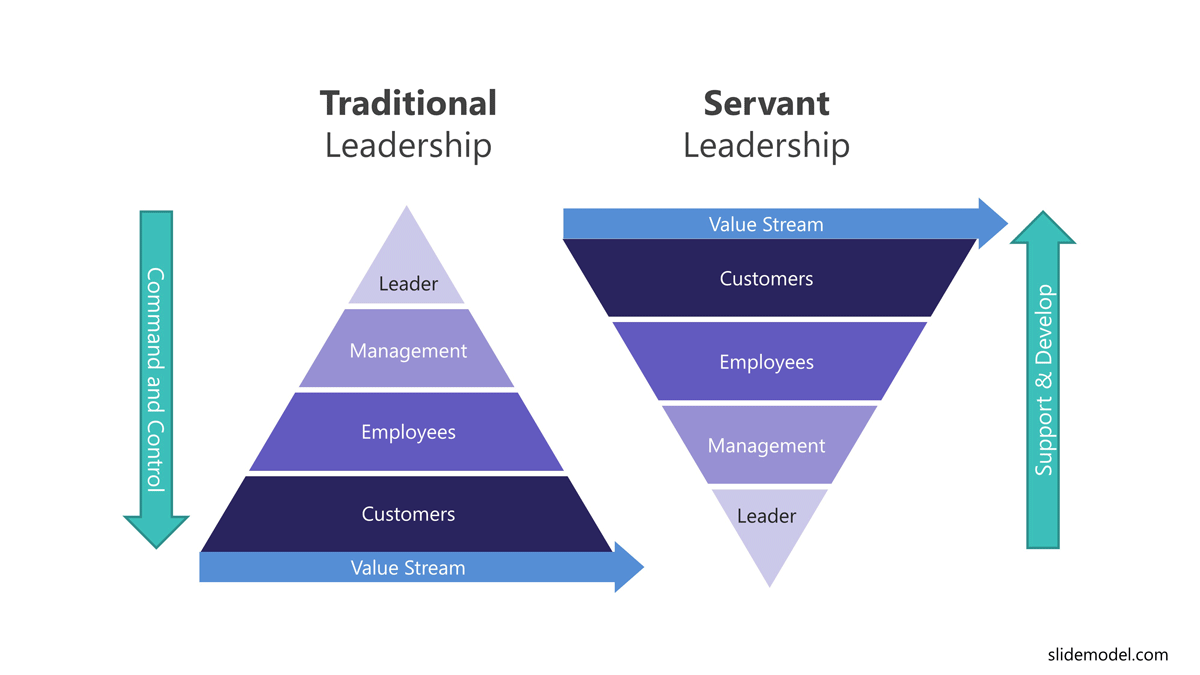
Organizational Charts
A top down organizational chart will typically have one individual at the top, a few below them, and the majority of positions at the bottom.
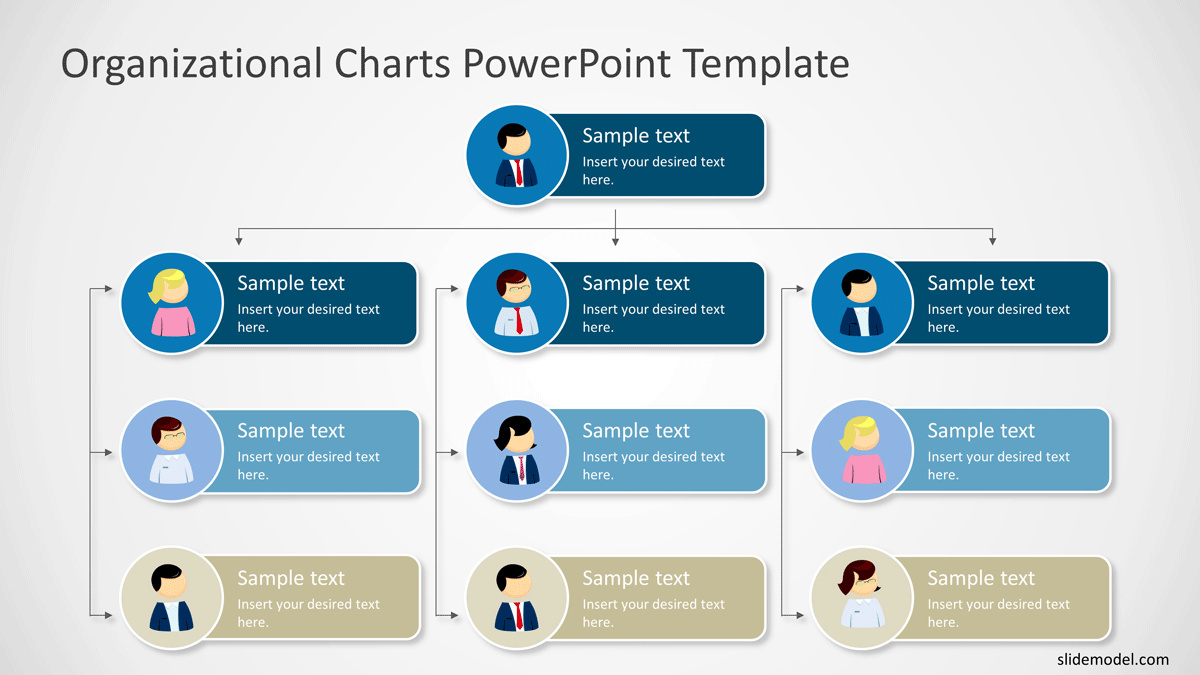
Meanwhile, a bottom up organizational chart will either be an inverted version of the previous chart, or one where multiple teams are located on the same level, such as in the example.
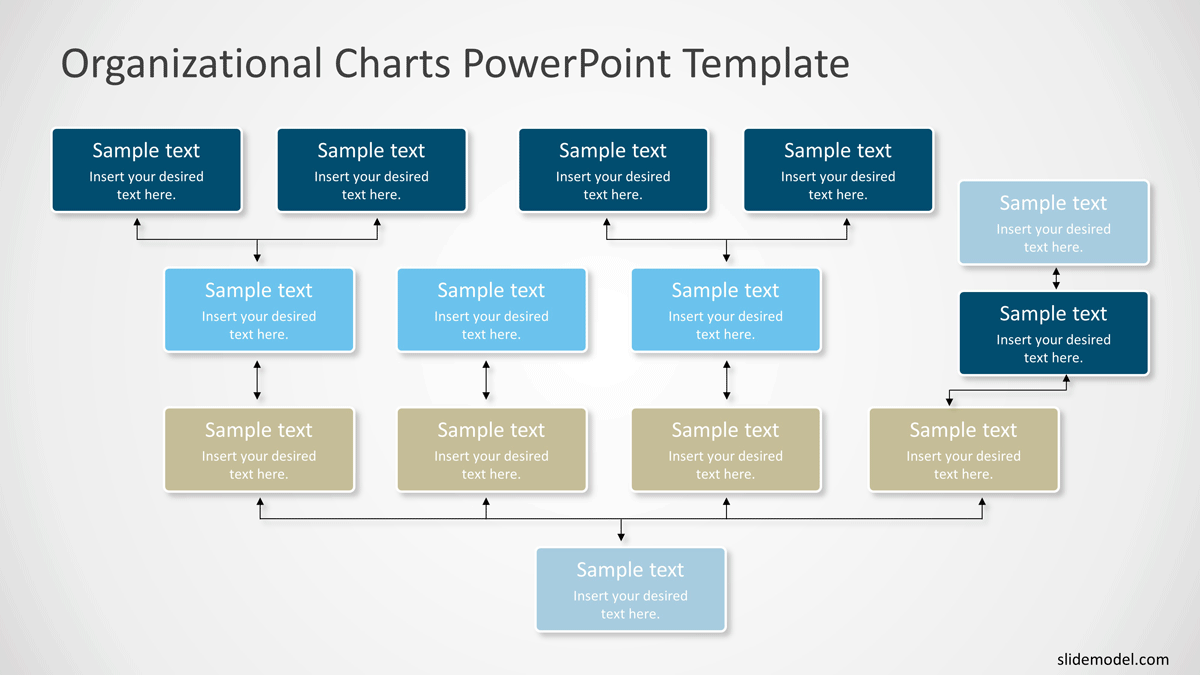
Conclusion
It’s impossible to say whether top down management or bottom up management is better. At the end of the day, it will depend wholly on the industry, leadership capabilities, and priorities of each organization to decide which management style will work best for them. No matter which management style a company chooses, there will be pros and cons. However, with the right team, the right skills, and best practices, organizations will undoubtedly be able to find success, regardless of which management structure works best for them.


